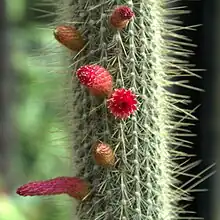| Cleistocactus parviflorus | |
|---|---|
 | |
| Scientific classification | |
| Kingdom: | Plantae |
| Clade: | Tracheophytes |
| Clade: | Angiosperms |
| Clade: | Eudicots |
| Order: | Caryophyllales |
| Family: | Cactaceae |
| Subfamily: | Cactoideae |
| Genus: | Cleistocactus |
| Species: | C. parviflorus |
| Binomial name | |
| Cleistocactus parviflorus (K.Schum.) Rol.-Goss. 1904 | |
| Synonyms | |
| |
Cleistocactus parviflorus is a species of columnar cacti in the genus Cleistocactus.
Description
Cleistocactus parviflorus grows as a shrub with upright, green shoots that are slightly branched at the base and reaches heights of up to 3 meters with diameters of up to 4 centimeters. There are 12 to 15 clearly notched ribs. The different colored thorns are brown to yellowish to greenish. The 1 to 3 central spines are up to 2.5 centimeters long, the 5 to 9 marginal spines are up to 4 millimeters long.
The straight, red flowers are 3 to 5 centimeters long. The yellow fruits are up to 1 centimeter in diameter.[2]
Distribution
Cleistocactus parviflorus is widespread in the Bolivian departments of Santa Cruz and Cochabamba at altitudes of 1400 to 3000 meters.
Taxonomy
The first description as Cereus parviflorus was made in 1897 by Karl Moritz Schumann.[3] The specific epithet 'parviflorus' is derived from the Latin words parvus for 'small' and -florus for '-flowered'. Robert Roland-Gosselin placed the species in the genus Cleistocactus in 1904. A nomenclature synonym is Echinopsis parviflora (K.Schum.) Anceschi & Magli (2013).
References
- ↑ "The IUCN Red List of Threatened Species". IUCN Red List of Threatened Species. 2010-09-21. Retrieved 2023-09-12.
- ↑ Anderson, Edward F.; Eggli, Urs (2005). Das grosse Kakteen-Lexikon (in German). Stuttgart (Hohenheim): Ulmer. p. 123. ISBN 3-8001-4573-1.
- ↑ Weber, Frédéric-Albert-Constantin (1904). Les Cleistocactus. Nice: Impr. Ventre. doi:10.5962/bhl.title.156757.
External links
 Media related to Cleistocactus parviflorus at Wikimedia Commons
Media related to Cleistocactus parviflorus at Wikimedia Commons Data related to Cleistocactus parviflorus at Wikispecies
Data related to Cleistocactus parviflorus at Wikispecies
